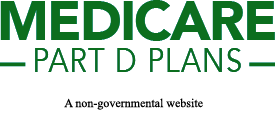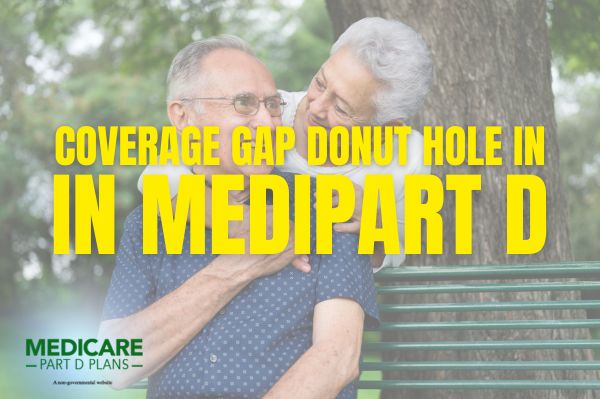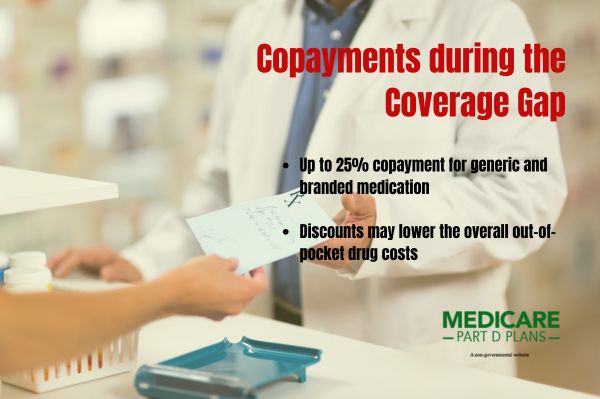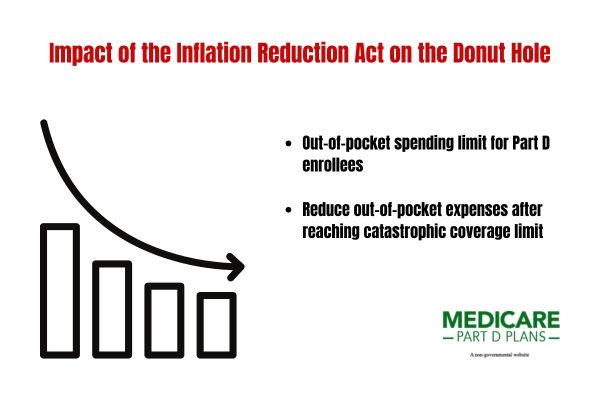Find a Medicare Part D prescription drug plan

Medicare Part D
Prescription Drug Coverage 2026
Coverage Gap Donut Hole in Medicare Part D: 2026 Explained
The Medicare Part D coverage gap
This article will explain what the coverage gap donut hole is, the potential changes, and what they could mean for your medical expenses.
Key Takeaways
In 2026 , Medicare beneficiaries may enter the ‘donut hole’ when total drug costs may exceed $4,660, potentially leading to higher out-of-pocket costs until they reach a limit to exit this phase.
- The Inflation Reduction Act might impact Medicare Part D by capping annual out-of-pocket spending at around $2,000 starting in 2025, possibly eliminating the donut hole and potentially improving affordability for beneficiaries.
- Beneficiaries may manage prescription drug costs during the coverage gap by opting for generic medications, discussing alternatives with healthcare providers, and utilizing available financial assistance programs.
What is the Coverage Gap Donut Hole?
The coverage gap, commonly known as the “donut hole” or Part D donut hole, refers to a period in Medicare Part D when beneficiaries pay a higher share of drug costs.
Before 2019, this gap may be particularly daunting, as beneficiaries will likely be responsible for paying up to 100% of their prescription drug costs upon entering it. This meant that people who rely on Medicare Part D might face financial hardships when their medication expenses suddenly spiked.
Thankfully, the Affordable Care Act (ACA) may help alleviate some of this burden. The ACA mandated that beneficiaries entering the donut hole may only pay up to 25% of their medication costs, possibly reducing out-of-pocket expenses.
Medicare Part D will likely cover a wide range of prescription medications, such as drugs for chronic conditions like HIV/AIDS and antidepressants. Yet, the high costs early in the year and the coverage gap might make it difficult for beneficiaries to afford their Medicare prescription drug medications.
Understanding this potential Medicare prescription drug coverage gap could be crucial for managing your prescription coverage drug expenses effectively.
How Does the Coverage Gap Work in 2026 ?
- Beneficiaries may need to pay a higher percentage of their drug costs until they reach the out-of-pocket limit.
- This phase follows the initial coverage period, where beneficiaries typically pay up to 25% coinsurance for covered Part D drugs.
- Once you enter the coverage gap, you will likely be responsible for a larger share of your medication costs until you reach the threshold to exit the gap.
The mechanism for calculating out-of-pocket costs during the coverage gap might include discounts on brand-name drugs, which will likely be designed to ease the financial burden on beneficiaries.
These discounts could potentially reduce the total costs, possibly making medications more affordable during this phase. Despite the higher costs that might be associated with the coverage gap, these discounts could play a crucial role in managing expenses.
The coverage gap is a temporary phase. Once you pay enough out-of-pocket costs to reach the exit threshold, you transition into the catastrophic coverage phase, where cost-sharing requirements may be reduced.
This structured approach could potentially provide a balance between out-of-pocket costs and the overall financial burden on beneficiaries.
Entry and Exit Thresholds for 2026
Beneficiaries may enter the coverage gap phase when their total drug costs reach a specified threshold:
- You will likely enter the donut hole once your total drug costs exceed about $4,660.
- This marks the transition from the initial coverage phase into the coverage gap.
- Entering the coverage gap might lead to higher out-of-pocket expenses.
The temporary limit for out-of-pocket costs
- Once your total out-of-pocket spending on prescription drugs reaches $2,000, you will likely exit the coverage gap.
- The annual out-of-pocket spending limit for beneficiaries in Medicare Part D might be set at around $2,100.
- The potential $2,100 limit may be slightly higher than the entry threshold for the catastrophic phase.
The potential adjustment of these thresholds will likely reflect the costs of prescription drugs and drug spending and may aim to balance the financial impact on beneficiaries. It’s essential to understand these potential thresholds to effectively plan and manage your medication expenses throughout the year.
Once you surpass the out-of-pocket spending limit, you exit the coverage gap and enter the catastrophic coverage phase. In this phase, your cost-sharing requirements may be reduced, possibly making your medications more affordable for the remainder of the year.
Understanding these potential spending thresholds and how they could impact your coverage could help you better navigate the complexities of Medicare Part D.
Copayments During the Coverage Gap
During the coverage gap, beneficiaries may be required to pay up to 25% of the cost for their medications. This will likely apply to both brand-name and generic drugs, meaning you may be responsible for at least a quarter of your medication costs during this phase.
However, there will likely be mechanisms in place to help reduce some costs. Beneficiaries could potentially receive discounts on brand-name drugs, which may lower the overall out-of-pocket drug costs.
These discounts will likely be part of the efforts to make medications more affordable during the coverage gap, possibly providing some relief to those who need it most, despite high drug costs.
Closing the Donut Hole: What’s Left to Address?
The evolution of Medicare Part D has seen several changes in recent years.
The Inflation Reduction Act (IRA) of 2022 likely played a crucial role in addressing the coverage gap, such as offering measures that might lower prescription drug costs and cap out-of-pocket spending. One of the potential changes may be the elimination of the donut hole after December 31, 2024.
With the donut hole potentially ceasing to exist from 2025 onwards, Medicare beneficiaries may experience simplified prescription drug coverage. This could mark a shift in how out-of-pocket costs may be managed, possibly making it easier for beneficiaries to plan and budget for their medications.
However, there will likely still aspects of Medicare Part D that need attention, particularly in terms of adjusting out-of-pocket limits for inflation.
The potential changes brought about by the IRA in 2025 will likely aim to improve affordability and predictability for Medicare Part D beneficiaries.
While the potential elimination of the donut hole may be a significant step forward, continuous efforts will likely be needed to address the remaining challenges and ensure that prescription drug coverage remains accessible and affordable for all.
Potential Impact of the Inflation Reduction Act on the Donut Hole
The Inflation Reduction Act (IRA) may introduce several changes to Medicare Part D, particularly affecting the donut hole:
- Starting in 2025, an out-of-pocket spending limit may be implemented for Part D enrollees
- This potential change could provide relief to those with high medication costs.
The out-of-pocket cap may also be indexed to increase annually after 2025:
- This potential adjustment may be based on the growth rate of per capita Part D costs.
- This could potentially ensure that the cap remains aligned with the actual costs of prescription drugs, possibly preventing beneficiaries from facing unexpected financial burdens.
- Additionally, beneficiaries may need to pay for covered medications after reaching the catastrophic coverage limit, which may further reduce their out-of-pocket expenses.
The potential removal of the coverage gap phase will likely streamline the cost structure for enrollees, possibly making it easier to manage and predict their medication expenses. These potential changes, driven by the IRA, will likely aim to make prescription drugs more affordable and accessible for all Medicare Part D beneficiaries.
Strategies to Help Manage Prescription Drug Costs in the Donut Hole
Managing prescription drug costs will likely be crucial for beneficiaries, especially during the coverage gap or donut hole in Medicare Part D. One effective strategy may be to opt for generic medications, which may be less expensive than brand name drugs.
Opting for generic drugs could potentially reduce your out-of-pocket expenses and stretch your budget further. Additionally, considering a brand name drug, when necessary, may also be part of a comprehensive approach to managing costs.
It’s also important to have open discussions with your healthcare provider about alternative medications that may be more affordable. Your health care provider could help identify cost-effective options that still meet your medical needs, possibly ensuring that you receive the necessary treatment without breaking the bank.
Additionally, several programs, including the Medicare program, are available to help reduce or eliminate certain costs, possibly providing significant support for beneficiaries. These programs could offer financial assistance, likely making it easier to manage your medication expenses during the coverage gap and access Medicaid services.
See plans in your area instantly!
Advertisement
Understanding Catastrophic Coverage Phase
Starting January 1, 2025, Medicare Part D will consist of three main coverage phases: the deductible phase, the initial coverage period, and the catastrophic coverage phase.
In the catastrophic phase, Medicare Part D plans may cover up to 20% of total drug costs. This phase will likely be designed to provide financial relief for beneficiaries who have high medication costs and is Part D coverage.
Once you reach the catastrophic coverage phase, you might not have to pay for covered medications for the remainder of the year. This could potentially mean that after spending about $2,000 in out-of-pocket prescription drug costs, you will likely transition into this phase, possibly reducing your financial burden.
Understanding this threshold and how it could impact your coverage may help you better plan your medication expenses and possibly ensure that you receive the necessary treatments without incurring excessive costs.
Importance of Reviewing Your Medicare Part D Plan Annually
Reviewing your Medicare Part D plan annually may be crucial to ensure that you have the best coverage and potentially minimize your costs. Comparing different Medicare drug plans and your Medicare drug plan could help you find options that may have lower medication costs and better benefits.
This annual review allows you to adjust your plan based on your changing medical needs and financial situation.
Members with limited income and resources can use Extra Help, a Low-Income Subsidy program. Additionally, state programs may be available to provide further assistance with drug costs for eligible individuals. Taking advantage of these resources could potentially reduce your out-of-pocket expenses and make your medications more affordable.
Staying informed and proactive about your Medicare Part D plan is essential. By reviewing your plan annually, you could potentially ensure optimal coverage, take advantage of available assistance programs, and manage your prescription drug costs effectively through the Medicare Part D program.
Find a Plan and Enroll Online Yourself!
Advertisement
Summary
The coverage gap, or donut hole, in Medicare Part D might present a significant financial challenge for beneficiaries. Understanding how the coverage gap works
The potential elimination of the donut hole, thanks to the Inflation Reduction Act, may mark improvements in the affordability and accessibility of medications for Medicare beneficiaries.
Staying informed and proactive is key. By reviewing your Medicare Part D plan annually and exploring strategies to manage your prescription drug costs, you could potentially ensure that you receive the necessary treatments without incurring excessive expenses. Remember, knowledge is power, and being well-informed about your Medicare benefits can make a world of difference in your healthcare journey.
Frequently Asked Questions
What happens in the catastrophic phase of the Part D benefit?
During the catastrophic phase of the Part D benefit, enrollees might not need to pay cost-sharing for covered drugs, while plan sponsors may cover up to 60% of all drug costs. This phase could potentially provide financial relief for beneficiaries facing high prescription expenses.
How might the Inflation Reduction Act affect Medicare Part D?
The Inflation Reduction Act could potentially enhance Medicare Part D by introducing an approximate $2,000 out-of-pocket spending limit and might eliminate the coverage gap phase, possibly simplifying costs for beneficiaries.
Why is it important to review your Medicare Part D plan annually?
It is important to review your Medicare Part D plan annually to identify more cost-effective options for medication, access assistance programs, and confirm that your coverage remains optimal. This proactive approach could lead to savings and better healthcare outcomes.
What strategies might help manage prescription drug costs during the donut hole?
One effective strategy to manage prescription drug costs during the donut hole may be to opt for generic medications and consult healthcare providers for alternative options.
Begin Choosing your plan
Advertisement
ZRN Health & Financial Services, LLC, a Texas limited liability company.



